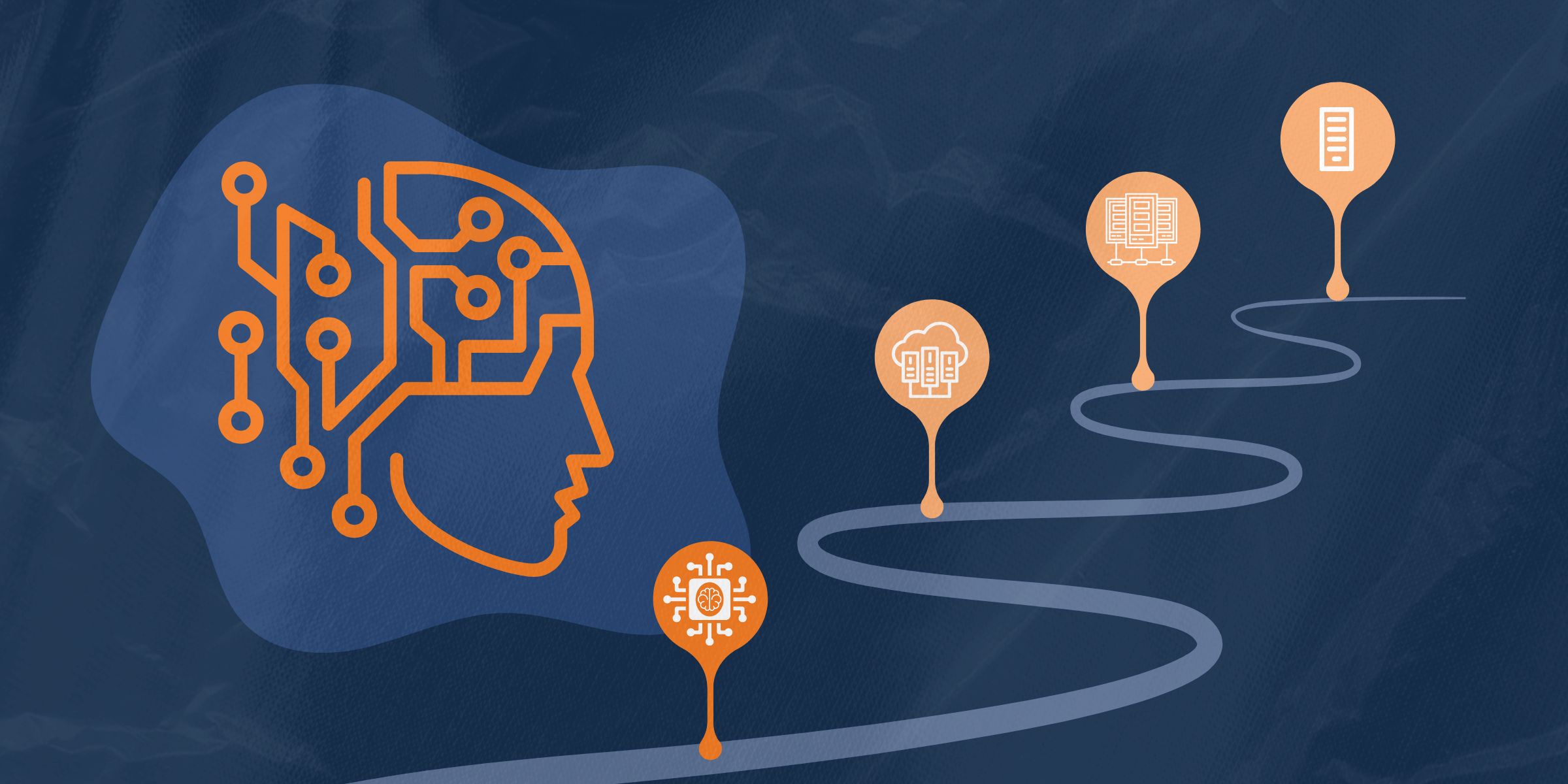8 min read
Unraveling the Evolution of Data Architecture: From Mainframes to Cloud-Powered Intelligence
Written by: TimeXtender - August 15, 2023

Hey there, data aficionados! Ready to take a stroll through the intriguing history of data architecture? Buckle up as we embark on a journey from the old-school mainframe days to the mind-blowing world of cloud-powered intelligence. We'll be exploring how this whole data thing went from clunky computers to the slick and smart systems we can't get enough of today.
Picture this: data architects of yore, armed with punch cards and determination, setting the stage for what would become the backbone of modern tech. We're diving deep into the twists and turns that shaped data architecture, from mainframe marvels to the cloud-based wizardry we now take for granted.
Navigating the Mainframe Maze

Think back to the days when computers took up entire rooms. Yup, that's where it all began. Our data pioneers wrestled with the challenge of centralized mainframes. These unsung heroes laid the groundwork for distributed computing and client-server setups, paving the way for smoother data highways ahead.
But boy oh boy, did our data pioneers have their hands full! Back then, the idea of computing was pretty much limited to number crunching. Imagine if you had to wait hours, even days, just to get the results of a calculation. Patience was definitely a virtue. But amidst all the clunkiness and slow processing, a spark of innovation was ignited.
These data architects weren't just playing around with wires and circuits; they were shaping the very foundation of how data would flow in the future. They saw the limitations of centralized mainframes and, being the trailblazers they were, began experimenting with distributed computing. It was like turning a solitary village into a bustling city, with data spread across multiple nodes, allowing for faster processing and increased efficiency.
These data architects weren't just playing around with wires and circuits; they were shaping the very foundation of how data would flow in the future.
Then came the game-changer: client-server architectures. Imagine a fancy restaurant where you're the client, and the chef, which is the database server, delivers exactly what you ordered. Similarly, data architects created a system where clients (users and applications) could request data from servers, which dutifully served up the required information. This not only sped things up, but also made computing more interactive and user-friendly. Suddenly, the data highway was looking less like a congested freeway and more like a well-organized express lane.
Data Warehousing Delights
Alright, let's fast-forward a bit, shall we? We're zooming past the days of clunky computers and punch cards, straight into the era of data warehousing and data marts. If the previous section was about the foundation, this one's about turning that foundation into a fabulous mansion of insights. Imagine a data paradise where nuggets of information are waiting to be discovered, much like Scrooge McDuck diving into his pool of gold coins.
Businesses started navigating the digital landscape, realizing that data wasn't just about crunching numbers anymore. It was a treasure trove of insights waiting to be unearthed. And just like that, data warehousing made its grand entrance. This was like organizing your closet, but instead of clothes, you're arranging data neatly so you can find that perfect outfit – erm, insight – in a snap.
Data architects became the ultimate curators, creating structures that could store and organize vast amounts of data. Think of it as a library for information, where instead of shelves, you have rows and columns of data tables. Suddenly, businesses had a central repository for all their data, from sales figures to customer behavior. No more hunting through a maze of spreadsheets; everything was neatly categorized and ready to be explored.
But wait, there's more! Data marts stepped into the spotlight. These were like specialized sections of the data warehouse, tailored for specific teams or purposes. Imagine having a mini museum inside a larger museum, dedicated solely to your favorite art style. Data marts provided teams with quick access to the information they needed, without sifting through the entire warehouse. It was like having a personal shopper for data – super convenient and incredibly efficient.
Suddenly, businesses weren't just making decisions based on gut feelings or educated guesses. They had concrete data to back them up. Marketing teams could analyze customer behavior trends, supply chains could optimize inventory levels, and financial departments could forecast with greater accuracy. It was like giving businesses a crystal ball, minus the smoke and mirrors.
Data warehousing and data marts turned the data landscape into a playground of insights. They allowed businesses to dive into their data and come up for air with actionable information. We went from floundering in a sea of data to doing a graceful butterfly stroke through organized insights. With these innovations, we all became a little smarter, a little more informed, and a lot more strategic in the way we made decisions.
The Cloud Rolls In
Hold onto your hats, because here comes the grand entrance of cloud computing! Imagine a stage with a spotlight, a few drum rolls, and a whole lot of anticipation. The tech world had its eyes wide open as the curtain rose on a whole new era of data architecture. Elastic resources? On-demand power? It was like data architecture traded in its bicycle for a sleek rocket ship, and for those who were there, it was one wild ride.

Before the cloud, organizations had to deal with physical servers and hardware. If you needed more power, you'd have to order new equipment, wait for it to arrive, and then set it up, taking time that could’ve been spent doing other things. But then, in waltzes cloud computing, like a superhero swooping in to save the day. Suddenly, you had the power to scale up or down with just a few clicks. It was like having a magical genie that granted your wishes for computing power, storage, and resources. Need more? Bam, done. Need less? Poof, it's gone.
The beauty didn't stop there. The cloud brought the concept of "pay-as-you-go" to the tech world. It's like going to an all-you-can-eat buffet, but only paying for what you actually consume. This flexibility meant that organizations could optimize their costs and resources, making budgeting a breeze.
Let us not forget about data architects – they got a shiny new toolkit with which to play. They could design architectures that spanned across different cloud providers, mix and match services like building blocks, and create intricate systems without worrying about the nitty-gritty of hardware maintenance. It was like someone handed them a Swiss Army knife with a hundred different blades. Suddenly, scaling up for a big event or handling unexpected traffic spikes became as easy as ordering a pizza. Organizations could focus on what they do best, while leaving the heavy lifting of infrastructure to the cloud providers. It was the ultimate liberation for businesses, freeing them from the shackles of physical limitations.

The cloud definitely revolutionized the game. It took data architecture from the era of hauling around heavy machinery to effortlessly soaring through the digital skies. The cloud wasn't just a new tool – it was a paradigm shift, a leap into a future where data could be harnessed like never before. As for data architects? Well, they went from playing with building blocks to orchestrating symphonies, all thanks to the magic of the cloud.
It's worth it to note there has been a recent shift in the mindset around cloud data strategies due to escalating costs, increased complexity, and diminishing returns on investment. Hybrid strategies (blending on-premises and cloud systems) have started to take hold, and it will be interesting to see what the future has in store for cloud computing.
Rise of the Machines
Welcome to the age of artificial intelligence (AI) and machine learning (ML), where data architecture isn't just a supporting player; it's the rockstar headlining the show. The very foundation of data design sets the stage for these futuristic technologies to strut their stuff and change the game yet again. The future isn't just knocking on the door – it's barging in with all the finesse of a determined squirrel raiding your bird feeder.
Imagine a world where your phone knows what you want before you even type it, where cars drive themselves, and where computers can paint like Picasso. This isn't science fiction; it's the power of AI and ML, and guess what? Data architecture is the unsung hero behind the scenes, setting the stage for these mind-bending capabilities.
Think of data architecture as the blueprint that AI and ML follow. It's like the foundation of a skyscraper – without it, the whole thing comes crashing down. These cutting-edge technologies thrive on data, and data architecture provides the framework to collect, store, and process the colossal amounts of information they require.
Imagine you're teaching a toddler to recognize animals. You show them pictures of dogs and cats until they can tell the difference on their own. AI and ML do something similar, but at lightning speed and with a dash of magic. They learn from data, making predictions, recognizing patterns, and improving their performance over time.
This is where data architecture steps onto the stage with a confident swagger. The data warehouses and marts of yesteryear have evolved into sophisticated systems that are data playgrounds where AI and ML algorithms romp around, gathering insights, and turning raw data into something profoundly insightful.

Data architects are the conductors of this high-tech orchestra. They design architectures that not only handle vast amounts of data, but also make it accessible, understandable, and most importantly, usable for AI and ML algorithms. It's like creating a perfectly tuned instrument for a virtuoso musician.
The insights derived from this marriage of data architecture and AI have transformed industries. Healthcare diagnoses are more accurate, financial predictions are sharper, and customer experiences are more personalized than ever.
TimeXtender and Data Architecture
We've been on a journey through the captivating history of data architecture, and now it's time to focus in on a tool that's making waves in this ever-evolving landscape.
Enter TimeXtender, the modern-day wizardry that's taking data architecture to a whole new level. It’s your trusty magic wand, ready to conjure up efficient, streamlined, and agile data solutions.
Data architecture isn't just about arranging data like pieces on a chessboard – it’s about crafting a symphony of data sources, connections, transformations, and insights. That’s where TimeXtender steps in – it's the conductor that brings all the instruments together in perfect harmony. With TimeXtender, you're not just dealing with data – you’re orchestrating it. It’s your toolkit for designing and managing data pipelines, transformations, and integrations.

TimeXtender shines when it comes to data integration. It takes data from various sources, whether they're in the cloud, on-premises, or somewhere in between, and pieces them together seamlessly. This means you can have data from your sales department shake hands with your marketing data, creating a united front of insights.
Data architecture isn't just about arranging data like pieces on a chessboard – it’s about crafting a symphony of data sources, connections, transformations, and insights.
But wait, there's more! TimeXtender doesn't stop at integration. It's all about automation, too. It’s a tireless assistant that handles data transformations, ensuring your data is clean, consistent, and ready for analysis. This automation not only saves you time, but also reduces the risk of human errors creeping into your data. We’re proud to be one of the first data automation and integration companies to add AI to our own product. We’ve also created XPilot, our AI-powered data integration co-pilot!

Let’s not forget about the magic word: agility. TimeXtender has the knack for adapting to changes. In this ever-evolving world, where data sources and business requirements shift like sand dunes in the Sahara, TimeXtender lets you pivot and adjust your data architecture with grace. It's like having a chameleon that effortlessly changes colors to match its surroundings.
Our Journey Is Complete… For Now
There you have it – the grand finale of our data architecture journey. From mainframes to cloud-powered dreams, we've arrived at the age of artificial intelligence and machine learning. Data architecture has evolved from humble beginnings to become the master key unlocking the door to a future where machines think, learn, and amaze us. It's a brave new world, and data architecture? Well, it's the true pioneer guiding us through the uncharted territory of tomorrow.
Whether you're a budding data whiz, a seasoned pro, or just someone who loves a good data tale, we hope this blog has been a fun trip down memory lane. We've journeyed from clunky mainframes to cloud-powered dreams, uncovering the evolution of data architecture every step of the way. It's not just tech history; it's the story of how we tamed the data beast and turned it into the powerhouse that drives our digital universe today.
Summary
- From the early days of mainframes to the cutting-edge realm of cloud-powered intelligence, there have been pivotal milestones that have shaped data architecture over the years, with advancements in technology, changing business needs, and emerging data paradigms having influenced its development.
- Beginning with centralized mainframe systems, early data architects faced challenges and overcame them by how they paved the way for distributed computing and client-server architectures. We then progressed into the age of relational databases and the role they played in revolutionizing data management, providing a solid foundation for data-driven decision-making.
- The birth of data warehousing and the emergence of data marts revealed how these innovations brought greater insights to businesses and empowered users with valuable information. The rise of big data made an impact on data architecture, driving the need for scalable and flexible solutions capable of handling vast volumes of information.
- The advent of cloud computing reshaped data architecture paradigms, allowing organizations to leverage the power of elastic and on-demand resources. Cloud-based data storage, processing, and analytics democratized data access and analysis for businesses of all sizes.
- The age of artificial intelligence and machine learning showcased how data architecture forms the bedrock for these transformative technologies. The future of data architecture is a landscape enriched by real-time analytics, data virtualization, and AI-driven insights.



